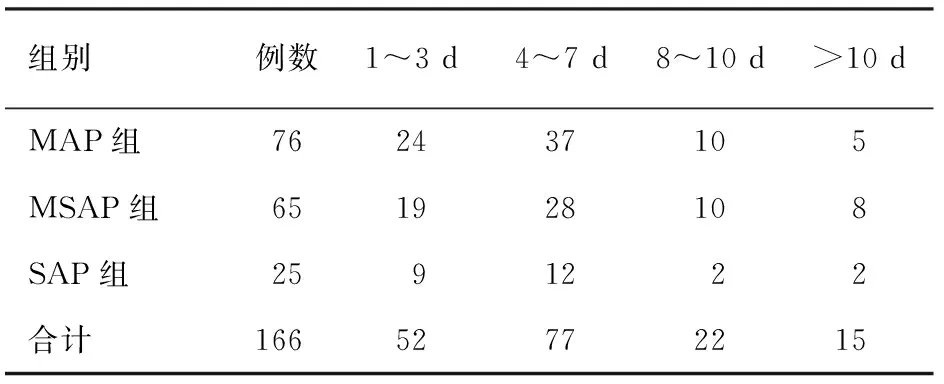2012年版急性胰腺炎分类标准的临床应用
2013-10-19吴青梁志海唐国都陈文静方春芸
吴青 梁志海 唐国都 陈文静 方春芸
·论著·
2012年版急性胰腺炎分类标准的临床应用
吴青 梁志海 唐国都 陈文静 方春芸
目的初步探讨2012年版急性胰腺炎分类标准的临床应用价值。方法回顾性分析2009年10月至2012年9月广西医科大学第一附属医院诊断为急性胰腺炎患者的临床资料。根据 2012年版分类标准将患者分为轻症急性胰腺炎(MAP)、中度重症急性胰腺炎(MSAP)、重症急性胰腺炎(SAP)3组。比较各组患者的好转及治愈例数、住院天数、住院费用、ICU入住率及入住天数、SIRS发生率及持续天数、Ranson评分、APACHEⅡ评分、CTSI评分的差异有无统计学意义。结果166例患者中MAP 76例,MSAP 65例,SAP 25例;男性119例,女性47例;平均年龄(49±15)岁;平均入院前发病时间为(2.27±1.46)d。3组患者的好转及治愈例数、住院天数、住院费用、入住ICU例数及天数、SIRS发生例数及持续天数、Ranson评分、APACHEⅡ评分、CTSI评分均随着疾病严重程度的增加而升高(P值均<0.01),其中SAP组患者相应值分别为21例(84.0%)、(23.8±13.6)d、(53900±30260)元、12例(48.0%)及(5.76±13.8)d、24例(96.0%)及(5.00±2.40)d、 (3.76±1.30)分、(8.52±4.24)分、(5.44±3.48)分。166例患者中79例发生局部并发症,其中急性胰周液体积聚34例,急性坏死物积聚45例。SAP组急性坏死物积聚发生率高于MSAP组(68.0% 比44.6%,P=0.047),而急性胰周液体积聚发生率低于MSAP组(16.0%比46.1%,P=0.016)。166例患者中42例发生器官功能衰竭,其中35例发生呼吸功能衰竭,2例发生肾功能衰竭,5例合并发生呼吸功能和肾功能衰竭。SAP组器官功能衰竭发生率为100%,MSAP组为26.2%,两组差异有统计学意义(P<0.05)。结论2012年版急性胰腺炎分类标准简便易行,能准确反映急性胰腺炎的严重程度,适于临床应用。
急性胰腺炎; 疾病严重程度指数; 国际疾病分类法; 亚特兰大
1992年亚特兰大召开的国际会议上将急性胰腺炎(acute pancreatitis, AP)分为轻症急性胰腺炎(mild acute pancreatitis, MAP)和重症急性胰腺炎(severe acute pancreatitis,SAP)[1]。SAP是指出现器官衰竭和(或)局部并发症。根据该分类标准,同为SAP患者的疾病过程、预后情况有很大差别。单器官功能衰竭及短暂性功能衰竭(持续时间<48 h)患者的ICU入住率及病死率要低于多器官功能衰竭及持续性器官功能衰竭(持续时间≥48 h)患者。2012年,美国亚特兰大国际AP专题研讨会对AP的临床严重程度分类进行修订[2],将AP分为MAP、中度重症急性胰腺炎(moderately severe acute pancreatitis, MASP)和SAP三种类型,将出现短暂性功能衰竭和仅出现局部并发症的AP患者归为MSAP。本研究回顾性分析166例AP患者资料,旨在探讨2012年版急性胰腺炎分类标准的临床应用价值。
资料与方法
一、病例资料
收集广西医科大学第一附属医院2009年10月至2012年9月收治的AP患者的临床资料。纳入标准:(1)符合2004年中国AP诊治指南诊断标准[3];(2)年龄≥18岁;(3)发病在1周以内入院的患者。排除标准:(1)胰腺创伤的患者;(2)合并妊娠的患者;(3)住院时间<48 h的患者;(4)住院期间未行增强CT扫描者;(5)慢性胰腺炎患者。
二、方法
记录患者的性别、年龄、发病时间、增强CT扫描时间(分为1~3 d、4~7 d、8~10 d、>10 d)、住院天数、住院费用、入住ICU情况及治疗效果。采用修订版Marshall器官功能障碍评分系统评估有无器官功能衰竭,并记录局部并发症,包括急性胰周液体积聚(acute peripancreatic fluid collection, APFC)、急性坏死物积聚(acute necrotic collection, ANC)、胰腺假性囊肿(pancreatic pseudocyst)和包裹性坏死(walled-off necrosis, WON)。无器官功能衰竭及局部或全身并发症者归为MAP组;出现短暂性器官功能衰竭(≤48 h)和(或)伴有局部或全身并发症者归为MSAP组;出现持续性功能衰竭者(>48 h)归为SAP组。每位患者入院后的前3 d进行APACHEⅡ评分,入院时及入院48 h进行Ranson评分。入院第1周内每天评估有无器官功能障碍、判断有无全身炎症反应综合征(systemic inflammatory response syndrome,SIRS)及持续天数。根据1990年Balthazar CT严重指数评分系统对每位患者的胰腺增强CT进行CTSI评分。比较3组患者的好转及治愈例数、住院天数、住院费用、ICU入住率及入住天数、Ranson评分、APACHEⅡ评分、CTSI评分、SIRS发生率及持续天数、器官功能衰竭和局部并发症等的差异有无统计学意义。
三、统计学处理
结 果
一、患者的基本信息
本研究共纳入166例AP患者,其中男性119例(72%),女性47例(28%),年龄18~90岁,平均(49±15)岁。男性平均发病年龄(47±1)岁,女性为(54±2)岁,女性发病年龄大于男性(P<0.01)。平均入院前发病时间为(2.27±1.46)d。
MAP 组76例(46%),MSAP组65例(39%),SAP组25例(15%)。3组的男女性别比分别为49/27、54/11、16/9,MSAP组的男性患者较MAP及SAP组多(χ2=6.83,P=0.03);平均年龄分别为(51±17)、(45±12)、(53±17)岁,MAP组和SAP组的平均年龄均较MSAP组大(χ2=4.16,P=0.017);发病时间分别为(2.11±1.26)、(2.40±1.54)、(2.15±1.34)d,各组间的差异无统计学意义(F=0.832,P=0.367);行增强CT的时间各组间的差异亦无统计学意义(F=2.62,P=0.855,表1)。

表1 3组患者在入院后不同时间行增强CT的例数
二、患者的好转及治愈例数、住院天数、ICU入住率及入住天数、SIRS发生率及持续天数、Ranson评分、APACHEⅡ评分、CTSI评分
3组患者的好转及治愈例数、住院天数、住院费用、ICU入住例数及天数、SIRS发生例数及持续天数、Ranson评分、APACHEⅡ评分、CTSI评分均为SAP组>MSAP组>MAP组(表2,表3)。SAP组患者APACHEⅡ评分及住院费用均显著高于MSAP组和MAP组(P值均<0.01),MSAP组和MAP组间的差异则无统计学意义。各组APACHEⅡ评分均为第1天最高,第2、3天下降,其中MAP组及MSAP组第2、3天的APACHEⅡ评分均显著低于第1天(P值均<0.05),但第2、3天间的差异无统计学意义,SAP组3天间APACHEⅡ评分差异无统计学意义(P>0.05)。
三、局部并发症及器官功能衰竭的发生情况
166例患者中79例发生局部并发症,其中APFC 34例,ANC 45例,无发生假性囊肿及WON病例。25例SAP中21例(84.0%)发生局部并发症,其中APFC 4例(16.0%),ANC 17例(68.0%);65例MSAP中59例(90.8%)发生局部并发症,其中APFC 30例(46.1%),ANC 29例(44.6%)。SAP组ANC发生率高于MSAP组(χ2=3.95,P=0.047),而APFC发生率低于MSAP组(χ2=5.76,P=0.016)。

表2 3组患者住院天数、入住ICU例数、SIRS发生例数等情况的比较

表3 3组患者Ranson评分、APACHEⅡ评分及CTSI评分的比较
166例患者中42例患者发生器官功能衰竭,其中35例发生呼吸功能衰竭,2例发生肾功能衰竭,5例合并发生呼吸功能衰竭和肾功能衰竭。SAP组呼吸功能衰竭及肾功能衰竭发生率分别为96%和24%,显著高于MSAP组的24.6%和1.5%(χ2=34.43,P<0.001;χ2=9.76,P=0.002)。SAP组器官功能衰竭发生率为100%,MSAP组为26.2%,两组差异有统计学意义(P<0.05)。SAP组出现器官功能衰竭患者的住院天数、住院费用、ICU入住率、SIRS发生率及持续天数、Ranson评分、APACHEⅡ评分均高于无器官功能衰竭患者(P值均<0.01)。MSAP组出现器官功能衰竭患者的住院天数、住院费用、SIRS发生率、Ranson评分、APACHEⅡ评分、CTSI评分与无器官功能衰竭患者的差别无统计学意义(P值均>0.05)。
讨 论
AP病程分为两个阶段。第一阶段为发病后的第1周[2-4],胰腺局部腺泡的炎症反应逐渐发展,部分患者可诱发SIRS,进而发生器官功能衰竭[5];第二阶段以局部并发症为主要表现,可持续数周甚至数月不等。早期SIRS引发的多器官功能衰竭和后期胰腺局部并发症的感染是AP患者的两个病死高峰[6]。
呼吸、肾脏和心血管系统为AP时最常出现器官功能衰竭的三大系统[7]。1992年亚特兰大会议对器官功能衰竭定义受诸多因素干扰:(1)呼吸系统中没有将吸入氧浓度考虑在内;(2)判断肾功能衰竭的标准未结合是否存在基础肾脏疾病;(3)循环衰竭的标准未考虑动脉压受补液和血管活性药物、强心药的影响。修订版Marshall器官功能障碍评估系统包括呼吸、肾脏和心血管系统,相应系统评分达到2分可认为该系统存在功能衰竭。本研究通过Marshall系统评估的器官功能衰竭患者的住院天数及费用、SIRS发生率及持续天数、ICU入住率均高于无器官功能衰竭者,且随着AP严重程度的升高,SIRS发生率及持续天数、Ranson评分、APACHEⅡ评分也随之升高。可见Marshall系统能客观反映AP的严重程度。
目前有多个预测AP严重程度的评分系统,如侧重临床指标的Ranson、APACHEⅡ、SIRS、Glasgow(Imrie)评分,日本急性胰腺炎严重程度评分(JSS评分),急性胰腺炎严重程度床旁指数(bedside index for severity in acute pancreatitis, BISAP)等,以及侧重胰腺形态学评估的Balthazar CT分级、CTSI评分。Ranson、APACHEⅡ、SIRS、CTSI评分是常用的评估AP严重程度的评分系统,具有较高的敏感性和特异性。然而传统的AP分类只有MAP和SAP两种类型。本研究显示,SIRS发生率及Ranson、APACHEⅡ、CTSI评分均随着AP严重程度的增加而升高,这些评分系统同样也适用于2012版的AP的分类。
在2012年分类标准中,局部并发症的类型对严重程度并无决定性影响,无论其是坏死或渗出、感染性或无菌性,只要不出现持续性器官功能衰竭均可认为是MSAP。本研究结果显示,MSAP组中出现短暂性器官功能衰竭(≤48 h)患者的住院天数、住院费用、Ranson、APACHEⅡ、CTSI评分和SIRS发生率与仅出现局部并发症患者无明显差别,表明新的分类标准符合患者的临床表现。
根据2012年的AP分类标准,将伴有胰腺(胰周)渗出的MAP患者以及出现胰腺坏死或短暂性器官功能衰竭的SAP患者归为MSAP,从而提高进入ICU的门槛,减少ICU相关并发症及医疗费用。近年来也有学者根据有无持续性器官功能衰竭情况以及局部并发症是否为感染性将AP分为轻、中、重和危重症急性胰腺炎(critical acute pancreatitis)4种临床类型[8]。局部并发症并发感染及持续性器官功能衰竭者为危重症AP,该类型有更高的介入治疗率及手术率。但该分类方法对介入有较高要求,不适用于介入技术较差的国家和地区,不及2012年分类标准简便、实用。
[1] Bradley EL 3rd. A clinically based classification system for acute pancreatitis. Summary of the International Symposium on Acute Pancreatitis, Atlanta, Ga, September 11 through 13, 1992. Arch Surg, 1993,128:586-590.
[2] Banks PA, Bollen TL, Dervenis C, et al. Classification of acute pancreatitis-2012: revision of the Atlanta classification and definitions by international consensus. Gut, 2013,62:102-111.
[3] 中华医学会消化病学分会胰腺病学组.中国急性胰腺炎诊治指南(草案).胰腺病学,2004,4:35-39.
[4] Zaheer A, Singh VK, Qureshi RO, et al. The revised Atlanta classification for acute pancreatitis: updates in imaging terminology and guidelines. Abdom Imaging, 2013,38:125-136.
[5] Singh VK, Wu BU, Bollen TL, et al. Early systemic inflammatory response syndrome is associated with severe acute pancreatitis. Clin Gastroenterol Hepatol, 2009,7:1247-1251.
[6] Blum T, Maisonneuve P, Lowenfels AB, et al. Fatal outcome in acute pancreatitis: its occurrence and early prediction. Pancreatology, 2001,1:237-241.
[7] Petrov MS, Vege SS, Windsor JA. Global survey of controversies in classifying the severity of acute pancreatitis. Eur J Gastroenterol Hepatol, 2012,24:715-721.
[8] Petrov MS, Windsor JA. Classification of the severity of acute pancreatitis: how many categories make sense? Am J Gastroenterol, 2010,105:74-76.
ClinicalapplicationoftheClassificationofacutepancreatitis-2012
WUQing,LIANGZhi-hai,TANGGuo-du,CHENWen-jing,FANGChun-yun.
DepartmentofGastroenterology,FirstAffiliatedHospital,GuangxiMedicalUniversity,Nanning530021,China
Correspondingauthor:TANGGuo-du,Email:tguodu02@yahoo.com.cn
ObjectiveTo investigate the clinical value of the Classification of acute pancreatitis-2012.MethodsMedical records and clinical data of patients with acute pancreatitis (AP) who were admitted to First Affiliated Hospital of Guangxi Medical University between October 2009 and September 2012 were retrospectively reviewed and analyzed. Patients were divided into mild acute pancreatitis (MAP), moderately severe acute pancreatitis (MSAP), and severe acute pancreatitis (SAP) groups according to the Classification of acute pancreatitis-2012. The number of improved and cured patients, length of hospital stay, hospitalization costs, rate of ICU admission, length of ICU stay, incidence of SIRS, and length of SIRS continue, Ranson scores, APACHEⅡ scores, computed tomographic severity index (CTSI) scores among the 3 groups were compared.ResultsOne hundred and sixty-six patients with AP (119 males and 47 females) were included, and 76 were MAP, 65 MSAP and 25 SAP. The average interval between AP onset and hospital admission was (2.27±1.46)d. The number of improved and cured patients, length of hospital stay, hospitalization costs, rate of ICU admission, length of ICU stay, incidence of SIRS, and length of SIRS continue, Ranson scores, APACHEⅡ scores, CTSI scores increased with the severity of AP. The corresponding values in SAP group were 21 cases (84.0%), (23.8±13.6)d, (53900±30260) Yuan, 48.0%(12/25) and (5.76±13.8)d, 96.0%(24/25) and (5.00±2.40)d, (3.76±1.30) score, (8.52±4.24) score, (5.44±3.48) score. Seventy-nine patients developed local complications, among them 34 was acute peripancreatic fluid collection, 45 was acute necrosis collection. The incidence of acute necrosis collection in SAP group was significantly higher than that in MSAP group (68.0%vs44.6%,P=0.047), but the incidence of acute peripancreatic fluid collection in SAP group was significantly lower than that in MSAP group (16.0%vs46.2%,P=0.016). Organ failure occurred in 42 patients, among them 35 cases were respiratory failure, 2 cases were renal failure, and 5 cases were respiratary and renal failure. The incidence of organ failure in SAP and MSAP group was 100% and 26.2%, the difference between the two groups was statistically significant (P<0.05).ConclusionsClassification of acute pancreatitis-2012 is a simple and convenient system, which can predict the severity of AP and appropriate for clinical application.
Acute pancreatitis; Severity of illness index; International classfication of diseases; Atlanta
2013-04-03)
(本文编辑:吕芳萍)
10.3760/cma.j.issn.1674-1935.2013.04.001
国家自然科学基金(81060043)
530021 南宁,广西医科大学第一附属医院消化内科
唐国都,Email:tguodu02@yahoo.com.cn
